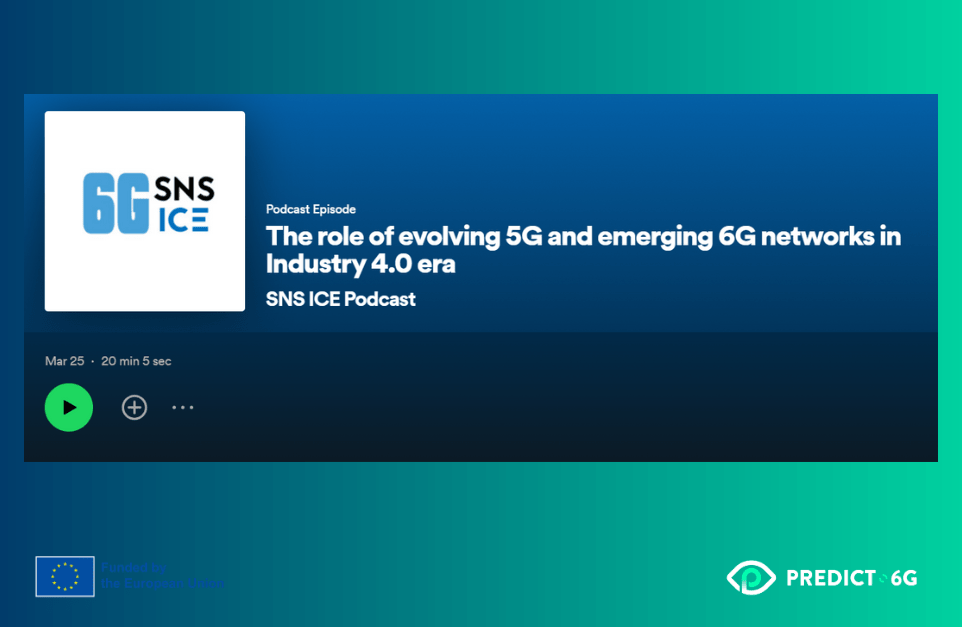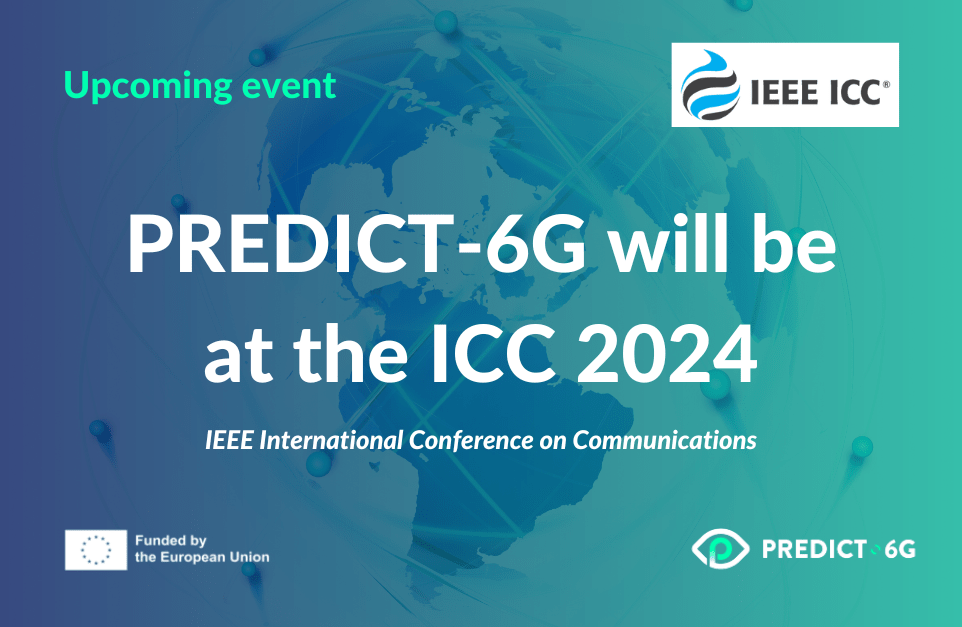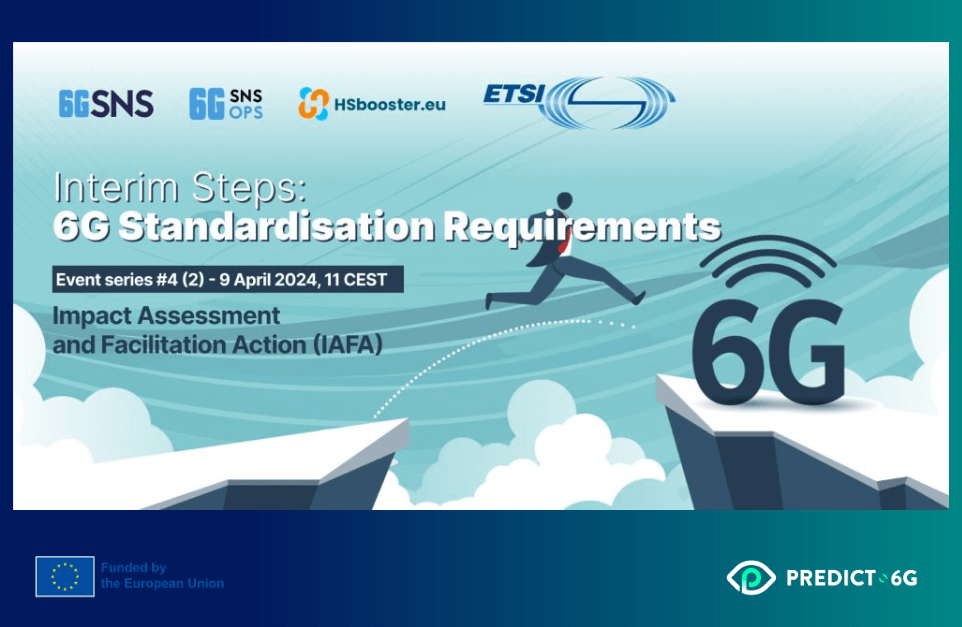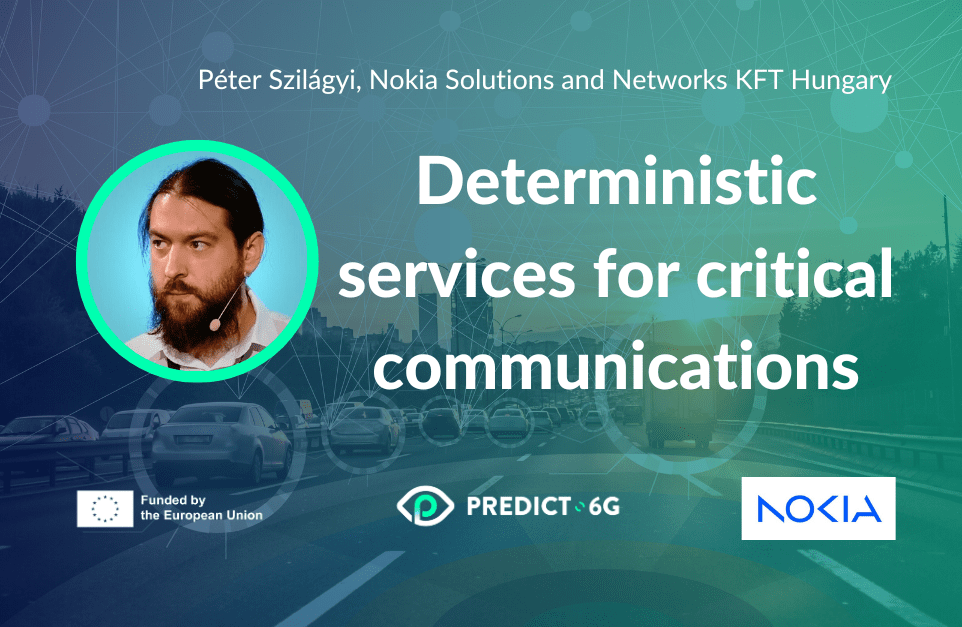6G SNS ICE Podcast: The role of evolving 5G and emerging 6G networks in Industry 4.0 era
Following the publication of the 5G-PPP Technology Board whitepaper on Innovation Trends in I4.0 enabled by 5G and Beyond Networks, the 6G SNS ICE project interviewed Manuel Lorenzo, Head of Technology & Innovation at Ericsson Spain, one of the PREDICT-6G partners, and editor and coordinator of this 5G-PPP whitepaper, for the latest episode of its podcast.
In a 20-minute conversation with Professor Ioannis Tomkos, Manuel Lorenzo covers many of the highlights and insights from their research on the convergence of 5G and I4.0, along with our best estimates for what the future still holds for us in this context. This 5G-PPP whitepaper captures the collective experience and analysis of a broad range of 5G-PPP projects addressing I4.0 challenges and scenarios, complemented with new views and perspectives from the SNS JU PREDICT-6G project.
The podcast is available on Spotify, don't miss it!
If you want to stay updated about PREDICT-6G, subscribe to our newsletter and follow us on Twitter and LinkedIn!
PREDICT-6G will be at the ICC 2024
In 2024, the IEEE International Conference on Communications (ICC) will take place on the 9 -13 of June in Denver, United States. PREDICT-6G will attend for the second consecutive year to the conference, which topic in 2024 is “Scaling the Peaks of Global Communications”.
Professor Carla F. Chiasserini (POLITO, CNR-IEITT and CNIT) will present the paper “Generosity Pays Off: A Game-Theoretic Study of Cooperation in Decentralized Learning” as part of the Edge Learning over 5G Mobile Networks and Beyond (EDGE5GMN) Workshop. In this paper, Prof. Chiasserini and her co-authors propose GENIAL, a game-theoretic approach to promote cooperation among user nodes for training or fine-tuning ML models.
If you want to stay updated about PREDICT-6G, subscribe to our newsletter and follow us on Twitter and LinkedIn!
PREDICT-6G will be at the WCNC 2024
The IEEE Wireless Communications and Networking Conference (WCNC) will take place on the 21-24 of April 2024 in Dubai, United Arab Emirates. PREDICT-6G will attend the conference, which theme in 2024 is “Wireless Communications for Growing Opportunities”. Its contributions will mostly focus on 6G architecture.
Dr. Sebastian Robitzsch (InterDigital) will present his paper “Formation and Assertion of Data Unit Groups in 3GPP Networks with TSN and PDU Set Support” in 6GARCH: the 3rd Workshop on 6G Architecture. Moreover, PostDoc David Rico Menendez (UC3M) will present the paper “6G Architecture for Enabling Predictable, Reliable and Deterministic Networks: the PREDICT6G Case” in the workshop 6GArch1: 6G Architecture roadmap.
If you want to stay updated about PREDICT-6G, subscribe to our newsletter and follow us on Twitter and LinkedIn!
PREDICT-6G on Standards Requirements
PREDICT-6G is one of the projects invited to participate in the IAFA#4.2 Interim Steps: 6G Standardisation Requirements that will take place on the 9 of April 2024. This is the second of a three-event series on pre-standardisation organised by SNS OPS, as part of its Impact Assessment and Facilitation Actions (IAFAs) initiative, in collaboration with ETSI and HSBooster.eu.
Carlos J. Bernardos (UC3M) will speak about the efforts of PREDICT-6G in standardisation, including how the project is internally organised to address standards-related issues and how it manages the cooperation with various SDOs. Carlos will also provide insights on PREDICT-6G achievements in the field thus far.
This second event delves into emerging 6G standardisation requirements and work items in the attempt to harmonise efforts between R&D projects and SDOs, with specific input on European SDOs. Emphasising the importance of collaborative efforts in research and development for 6G, this workshop aims to foster discussions on how ongoing research projects can contribute to the creation of standards.
You can register for the event here.
If you want to stay updated about PREDICT-6G, subscribe to our newsletter and follow us on Twitter and LinkedIn!
Deterministic services for critical communications
By Péter Szilágyi, Technical Manager
A communication may be considered critical if the functional capability, operational capacity, and safety of the communication endpoints and their implemented solution depend on the communication service’s availability, reliability, and performance. In such scenarios, the communication and thus the underlying network play an inseparable role in realizing an end-to-end solution. Example scenarios include cloud robotics; factory automation (e.g., implementing manufacturing or production workflows); AR/VR based interactions (potentially extended with cloud annotations); distributed sensor data collection, analytics, and command & control of physical devices; and many others. In such cases, the operation of the end devices, cloud application and the overall end-to-end solution imposes deterministic requirements on the network and communication service that interconnects them.
Mobile devices such as AGVs, drones, AR/VR headsets or even smartphone-based applications may also engage in collaborative tasks executed in the physical space requiring deterministic service. It requires that the network can provide deterministic communication within a dynamically evolving group, where devices are joining/leaving a group in an ad-hoc manner according to, e.g., the interest of their users, their interaction in the virtual space, their mobility or physical proximity.

Cloud applications may be responsible for the monitoring and control of the devices and serving as rendezvous points to enable cloud-based group communication and data sharing across a large set of distributed devices that share a common task, physical or virtual environment or mission. In all these cases, it is important that the devices and the cloud applications participating in the same collaborative relation stay synchronized concerning their shared application state and thus need to exchange information, data, commands, and contextual information through deterministic and reliable communication services.
The Nokia Open Lab will implement and demonstrate use cases related to the critical communication requirements, which may manifest in concrete scenarios such as real-time sensor data collection and machine control; group communication of multiple devices via a rendezvous point; or camera sharing across multiple devices.
If you want to stay updated about PREDICT-6G, subscribe to our newsletter and follow us on Twitter and LinkedIn!
PREDICT-6G will be at the EuCNC 2024
The 2024 EuCNC & 6G Summit will take place from the 3rd to the 6th of June in Antwerp, Belgium. Combining two successful telecoms conferences: ECNC (European Conference on Networks and Communications), supported by the European Commission, and the 6G Summit, originating from Finland's 6G Flagship programme, the event is now one of the largest in the sector.
It brings together cutting-edge research and world-renowned industries and companies, globally attracting over 900 delegates from more than 40 countries around the world in recent years. PREDICT-6G returns for the second consecutive year, to repeat the successes of the 2023 edition and establish itself as one of the leading projects in 6G.
PREDICT-6G will be present in three workshops, both in the organisational part and in the presentations slots:
“Architectural Considerations Enabling the IMT 2030 Framework by European 6G R&D Activities”. This workshop, proposed by PREDICT-6G consortium members InterDigital Europe Ltd, Nokia and Universidad Carlos III de Madrid, together with NEC Laboratories Europe, Eurescom and Aristotle University of Thessaloniki, will present the 6G SNS projects architectural design innovations, challenges and opportunities, combined with early findings and potential impacts towards 6G, around six usage scenarios and four overarching aspects.
The workshop is formed around the six IMT 2030 usage scenarios set out by the ITU-R, complemented by the four overarching aspects on sustainability, connecting the unconnected, ubiquitous intelligence and security/resilience. Each IMT usage scenario will be addressed by a consolidated presentation from multiple relevant projects from the 6G Architecture Working Group, including PREDICT-6G.
“Trials, Pilots and Demos for Selected Verticals: the Experimental Way Forward towards 6G”. This workshop, co-organised by the 6G-SANDBOX, 6G-XR, FIDAL, SNS-ICE and PREDICT-6G projects, will share the views, achievements, and lessons learnt from the realisation of early trials, pilots and demonstrations in the respective projects. It will also provide information and guidance on how third parties can benefit from the experimental infrastructure being developed by these projects to carry out additional experimental work.
Collectively, the SNS projects taking part in this workshop have in-depth knowledge and practical insights in key verticals for the EU economy such as industrial manufacturing, media and entertainment, gaming, public protection and disaster relief, or smart cities. This will guarantee a balanced coverage in the technical sessions, as well as the exchange of valuable and diverse points of view in the final panel discussion.
"The 6G series workshop by Hexa-X-II". This workshop, organised by the european 6G flagship research project Hexa-X-II, will address the conference tracks ‘PHY—Physical Layer and Fundamentals’, ‘WOS – Wireless, Optical and Satellite Networks’, ‘NET – Network Softwarization’ ‘AIU Applications, IoT, Use Cases’ and ‘6G Visions and Sustainability’, by providing an overview on the 6G research from the major European players. This will be accomplished by inviting other SNS JU Stream B 6G technical enabler projects to present, such as PREDICT-6G.
The workshop is divided into 4 sessions of 90 minutes, and it will be in session 3 - 6G Architecture (90 min) where the coordinator of PREDICT-6G, Antonio de la Oliva (Universidad Carlos III de Madrid) will participate. He will give a 12-minute presentation entitled ‘The importance of predictability in 6G networks’.
Stay tuned for more detailed information!
If you want to stay updated about PREDICT-6G, subscribe to our newsletter and follow us on Twitter and LinkedIn!
DEMO: Target Wake Time (POLITO)
Use cases are at the heart of PREDICT-6G. They are the way for our research and use case providers to experiment, validate and demonstrate how PREDICT-6G technologies enable a reliable, predictable and time-engineered 6G network. Claudio Casetti, Full Professor at Politecnico di Torino and a researcher in the PREDICT-6G consortium led the “Target Wake Time” demo.
This demonstration shows the evolution of Wi-Fi networks with the introduction of Target Wake Time (TWT), a feature that transforms the way devices communicate within a network. Traditionally, Wi-Fi networks were based on CSMACA principles, which allowed efficient collision resolution but introduced randomness in channel access and transmission timing. The demonstration delves into how TWT, initially introduced in 802.11 AH and later integrated into Wi-Fi 6 (802.11 AX), addresses these challenges.
Using simulations with 8 strategically spaced stations, the demonstration compares TWT-enabled communication with standard Wi-Fi, highlighting TWT's deterministic latency and significant energy savings.
You can watch the demo here and below.
If you want to stay updated about PREDICT-6G, subscribe to our newsletter and follow us on Twitter and LinkedIn!
DEMO: Smart Factory (Gestamp and Ericsson)
Use cases are at the heart of PREDICT-6G. They are the way for our research and use case providers to experiment, validate and demonstrate how PREDICT-6G technologies enable a reliable, predictable and time-engineered 6G network. Marc Mollà, Chief Solution Architect at Ericsson and a member of PREDICT-6G, led the "Smart Factory" demo.
This demonstration shows the application of Time Sensitive Networking (TSN) capabilities in 3GPP networks, with a specific focus on a Gestamp -inspired smart factory use case. The objective is to move from a wired configuration to a wireless LAN scenario using a 5G network, emphasising the challenges of interconnecting numerous mobile components in a factory environment.
Overall, the demo highlights the potential integration of TSN enhancements into 5G systems, offering improved spectrum sharing, reduced network congestion, and enhanced reliability for mission-critical industrial applications, even without specialised TSN-supported hardware like commercial UE's or Ethernet-based protocols.
You can watch the demo here and below.
If you want to stay updated about PREDICT-6G, subscribe to our newsletter and follow us on Twitter and LinkedIn!
Demo: Real time gesture based remote control of a digital twin
PREDICT-6G coordinator, Antonio de la Oliva, shows us the demo: Real time gesture based remote control of a digital twin, jointly developed by the Universidad Carlos III de Madrid (UC3M) and 5TONIC - Telefónica's Open Lab, one of the two open labs where PREDICT-6G tests its use cases.
This demonstration shows how the combination of three different key technological enablers, namely: physical system co-simulators, 5G and beyond, and sensing, perception and collaboration in the physical environment, can enable remote operation based on the robotic dog's gestures.
The demo has been made possible thanks to the support of Horizon Europe's Smart Networks and Services (SNS) projects DESIRE6G and PREDICT-6G; and the UNICO R&D projects 6G-DATADRIVEN and 6G-EDGEDT.
Watch the demo below.
UNICO is a Spanish programme to strengthen RDI activities to consolidate Spain´s leadership in European and national projects of cloud infrastructure, edge computing technology, semiconductors, and quantum communication.
PREDICT-6G demonstration at MWC Barcelona 2024
MWC Barcelona, the largest and most influential event in the connectivity sector, was held on the 26-29 February 2024. It brought together more than 28,000 organisations in a total of over 2,700 exhibitors, one of which was PREDICT-6G consortium member InterDigital. InterDigital had a strong presence at MWC, with a stand that included, among other things, several demos showing how innovation powers connected experiences at work, at play and at rest.
At Work: Sensing-Enabled 6G Mobile Networks, was the space where InterDigital showcased sensing-enabled 6G mobile networks through a connected factory environment. Using InterDigital's sensing and communication technology to retrieve and send real-time information from network sensors and devices, the InterDigital team showed how their contributions to this fundamental 6G function can unlock new potential for consumers and businesses. One of these contributions is the PREDICT-6G demonstration called "Novel User Plane concepts for deterministic communications in an ISAC setting".
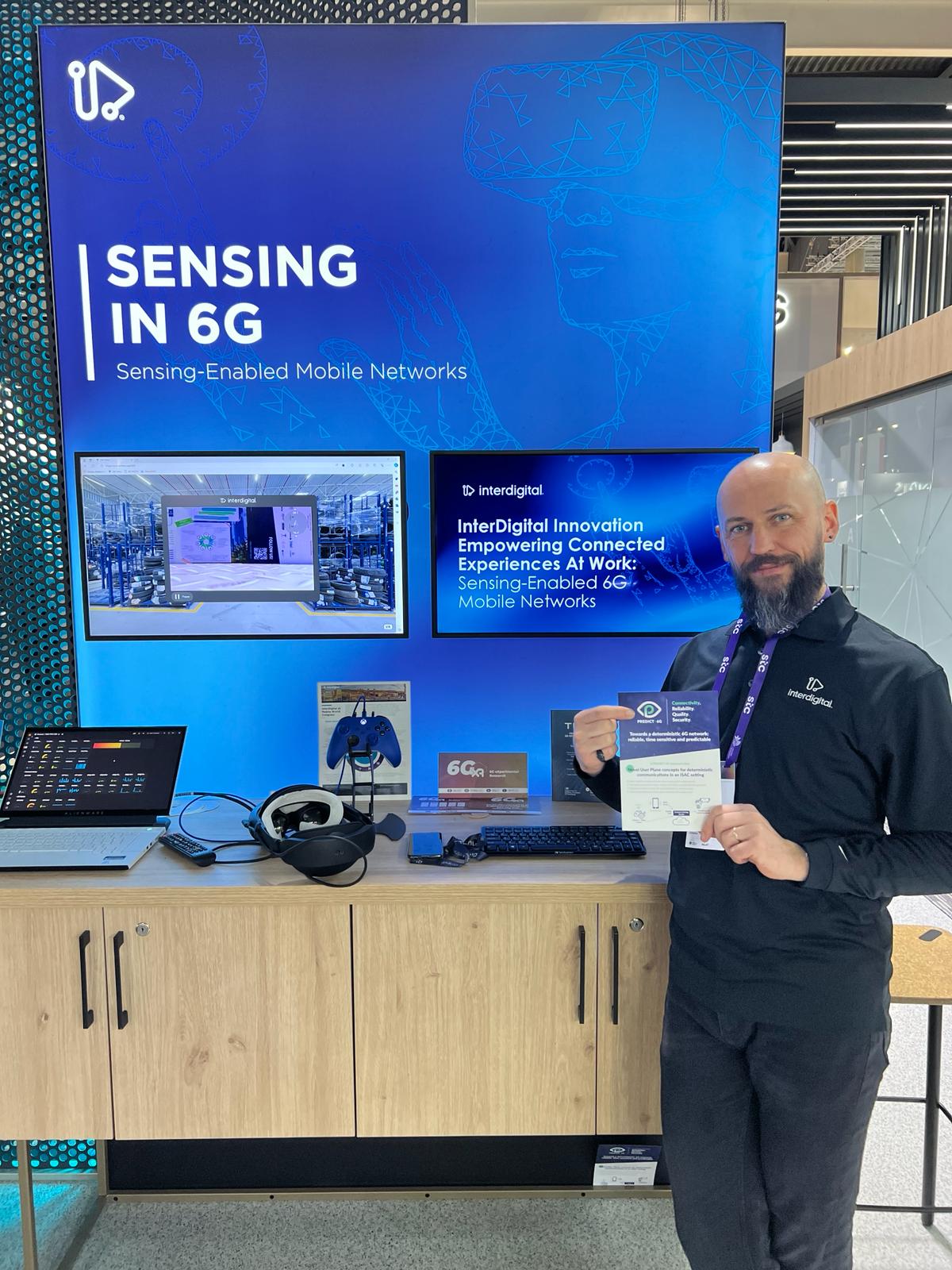
Dr. Sebastian Robitzsch from InterDigital, responsible for the standardisation of PREDICT-6G, showed our demo to the visitors of the MWC. The demonstration featured a mobile network for seamless wireless connectivity in a warehouse. An autonomous vehicle, equipped with distance and camera sensors, was connected to this network. Additionally, radar sensors on mobile devices enhanced security by detecting objects. Users controlled the vehicle remotely with a wireless glove, and sensor data was processed in the mobile network before being integrated into an application, enabling precise navigation in the warehouse.
If you want to stay updated about PREDICT-6G, subscribe to our newsletter and follow us on Twitter and LinkedIn!

